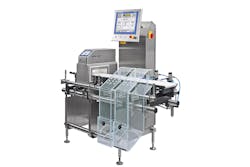Conformity in packaged food strengthens brand value, avoids costly product recalls by upholding food safety regulations and delivers consistent bottom-line profits.
These 10 steps from Mettler Toledo Product Inspection guide packaged food manufacturers and brand owners in achieving conformity.
1. Comply with regulations and supplier agreements
Packaged food manufacturers are governed by laws regulating three main areas: food safety, weight and labeling. These regulations are supported by best practice codes of conduct published by global certification bodies that give manufacturers access to trade with retailers in specific countries. The packaged food must have completed Steps 2–8 below. Certain products, notably dairy and meat, have additional legal requirements. On top of this, some international retailers have proprietary supplier agreements detailing further standards such as proactive sustainability programs.
Tip: Understand the relevant compliance requirements governing your products and the markets where and with whom who you want to trade.
2. Inspect for contaminants
To safeguard consumers, all packaged food must be free from unwanted contaminants. Metal detection or X-ray systems provide inspection solutions that detect and remove contaminated packages from production lines, at high throughputs.
Tip: Select the optimum detection technology based on the potential types of contaminants, and the nature and format of the packaged products.
Vision systems such as this Mettler Toledo V2622 can verify cap integrity, fill level and label presence and condition in one inspection, saving time and conserving line space.
3. Confirm product integrity
A packaged product can be compromised if the integrity of the seal or cap is breached. For example, a misaligned closure or dense product trapped under the seal (or film) can lead to spills, spoilage or risk of bacterial contamination.
Tip: Advanced vision inspection and X-ray technologies can both perform in-line integrity checks to ensure product quality.
4. Ensure correct weight
To comply with local and global directives, the weight of each package must be within predefined tolerances. Packages below tolerance violate the law; packages above tolerances are giving away excess product. Checkweighing technology provides 100 percent inspection of packages at production speeds and rejects products that fall outside the parameters. Consistently achieving target weights protects profits and brand reputation. Checkweighing can also detect packages with missing components, monitor production line filling efficiency and identify areas for improvement.
Tip: Choose in-line checkweighers that accurately and consistently ensure target and also support overall equipment efficiency (OEE).
5. Confirm product content integrity
Safeguarding against missing components and confirming that the correct amount of product is in each section or package is vital to upholding brand reputation. X-ray technology and vision inspection systems can verify that the composition of each package is complete and correct.
Tip: Today’s advanced X-ray and vision systems perform multiple content presentation checks simultaneously in real time and at production line speeds.
6. Inspect label positioning
Labeling errors, including missing or incorrectly positioned labels, can result in product rework, U.S. Food and Drug Administration (FDA) recalls and damage to brand value. Vision technology inspects the positioning of all labels on a package at production line speeds and removes all nonconforming products from the line before they can reach the marketplace.
Tip: Validating label positioning helps to uphold brand value and protects bottom-line profits by making it easier to rework nonconforming products.
7. Verify label content
Incorrect or unreadable labeling accounts for more than half of FDA recalls. Accurate label content is paramount to enable consumers to make informed decisions by avoiding potential health risks caused by, for example, allergens. Incorrect, misapplied or unreadable labeling violates labeling regulations, breaches trading agreements and can lead to highly publicized product recalls. Innovative vision inspection technology uses preprogrammed details to verify label content, including text, graphics and codes.
Tip: Use vision inspection to confirm correct and complete labeling content and avoid potentially damaging recalls and/or legal liabilities.
8. Monitor inspection activities in real time
All product inspection activities should be recorded in real time. In the event of a product recall, the manufacturer will need this information to prove due diligence to authorities and to reliably trace products. It will also be useful in the event of an FDA facility inspection. Ongoing monitoring of inspection processes can also help to optimize operational efficiencies and productivity.
Tip: To safeguard your business, integrate data collection and inspection software to prove due diligence and to fuel your continuous improvement programs.
9. Ensure your package is perfectly presented
Brand conformity includes upholding packaging presentation requirements, from ensuring zero packaging imperfections, such as label wrinkles and package dents, to the correct use of corporate brand imaging.
Tip: Vision inspection and X-ray technologies ensure that packages are presented in peak visual and physical condition.
10. Check the checkers
Packaged food that consistently conforms to both regulatory and brand image standards instills confidence in consumers and builds brand loyalty. It is essential that critical equipment such as inspection systems are regularly monitored, validated and calibrated to ensure continuing high levels of accuracy.
Tip: Consistency in packaging quality and visual appearance is the most critical key to retaining and growing market share. In addition to onsite monitoring, subscribing to a maintenance contract with your inspection equipment manufacturer can also be a wise investment.
Resources
"Ensuring conformity of packaged food: How manufacturers and brand owners can benefit from conformity of packaged foods," by Mettler Toledo: https://www.mt.com/us/en/home/library/white-papers/product-inspection/pi-conformity-of-packaged-food.html.
Robert Rogers, senior advisor for food safety and regulation at Mettler Toledo Product Inspection Group, serves as a subject matter expert to various regulatory and industry organizations such as the U.S. Food and Drug Administration (FDA), Grocery Manufacturers Association (GMA) and PMMI, The Association of Packaging and Processing Technologies. Rogers presents at various trade shows and conferences and writes articles and blogs about this critical industry issue. He may be contacted at [email protected] or 813-342-9138.
About the Author
Robert Rogers
Senior advisor for food safety and regulation at Mettler Toledo Product Inspection Group,
Robert Rogers, senior advisor for food safety and regulation at Mettler Toledo Product Inspection Group, serves as a subject matter expert to various regulatory and industry organizations such as the U.S. Food and Drug Administration (FDA), Grocery Manufacturers Association (GMA) and PMMI, The Association of Packaging and Processing Technologies. Rogers presents at various trade shows and conferences and writes articles and blogs about this critical industry issue. He may be contacted at [email protected] or 813-342-9138.

